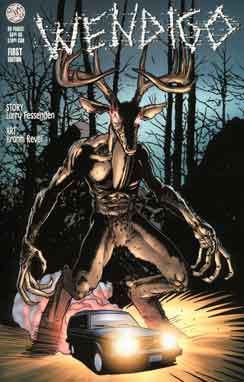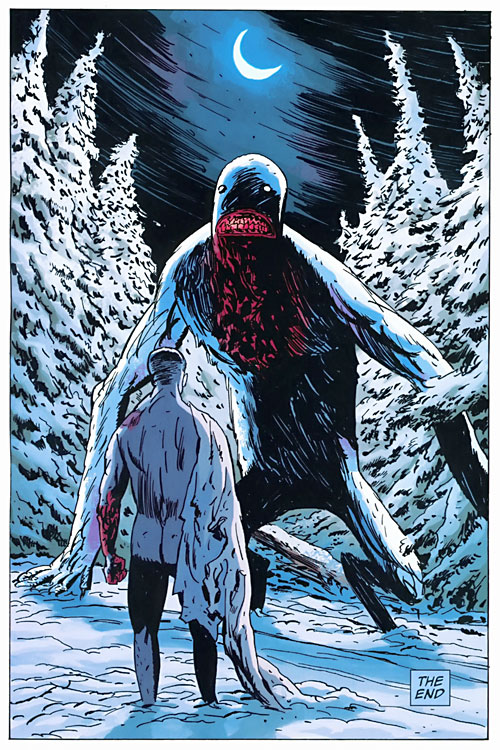Songs Long Ago Of The Wendigo
Posted by: Loren Coleman on January 20th, 2009

Once upon a time, yet another comic book appeared with the Wendigo theme. Folk songs have materialized, as well, about the strange beast.
Do you know of any old folk songs of cryptids?
I’m reminded of one, of a weird creature in Canada, which I discussed in Mysterious America.
Mention of it is in the Songs of the Miramichi, in Folksong No. 47, which is entitled, “The Wild Cat Back on the Pipe Line.” It told of the people who saw a strange animal while they were working along the pipeline. One passage goes:
The next one that saw it, his name was LeClair.
He said ‘twas no monkey, nor neither a bear,
For he came from Australia and knows it is true,
For he saw many like it, ‘twas a big kangaroo.
This song, written by Jared MacLean, is dated 1948, and serves as a historical backdrop to the recent mystery kangaroo reports I was tracking out of New Brunswick. As the title of the song demonstrates, the kangaroo and phantom panther accounts often merge. But was the song about a mystery felid, a mystery ‘roo, a peculiar primate, or a Windigo (a/k/a Wendigo and other forms)?
My friend Jerome Clark, well-known researcher, scholar and author of Fortean and anomalistic works, has written some modern songs in the style of folk songs. That fact also naturally means he collects various cryptid folk songs.
He writes:
Old folk songs and ballads sometimes evoke encounters with ghosts, demons, fairyfolk, mermaids, and other such entities (even, in one elusive instance I have been trying to document
since the 1970s, a mid-19th-Century Nebraska sky serpent).
Maybe the readers of Cryptomundo can assist him with that special quest. Do you know any 19th Century folk songs about “sky serpents”?

Figurine above is from the Hulk Legends Series 1: Wendigo.
Jerry Clark continues:
I do a lot of CD reviewing, so packages containing new releases regularly show up on my doorstep. Yesterday brought a disc from the folksinger Mickey Clark (no relation), Winding Highways. Among the cuts is a song, “Wendigo,” written by Dwain Story in the 1960s. I’d known vaguely of its existence, but this is my first hearing of it.
Clark’s liner notes remark, “The Wendigo is a Native American legend shared by the Cree and the Ojibwa, and is said to be half-bird and half-man, with fiery feet.”
On the other hand, anthropologist Richard J. Preston has written that the Wendigo (Witiko in some spellings) is a “cannibalistic, monstrous person reported to have been encountered by Algonkian Indians in the northern forest.”
Wendigo legends are sometimes cited in the Sasquatch literature. Several academic papers on the subject, including Preston’s, are to be found in Marjorie Halpin and Michael M. Ames, ed. Manlike Monsters on Trial: Early Records and Modern Evidence (Vancouver and London: University of British Columbia Press, 1980). ~ Jerry Clark
“Wendigo” by Dwain Story
My home’s way up to the north they say
Where the hunter may die all alone
Red men have told a legend so old
Of death whose sound is a moan.
Chorus:
I fly where the forest meets the sky
I race the northern wind where I go
My feet are on fire as I run and I cry
My name is Wendigo.
Where I walk are the prints of my feet
They burn through ice and snow
And the hunter who sees looks above in the trees
It’s the mark of the Wendigo.
Chorus.
White lakes and trees in the moonlight
A sound so lonesome and low
Is it the wind, or a cry in the night?
Wendigo, Wendigo.
Chorus.
The image below of a Wendigo confronting a human is from the Dark Horse comic series B.P.R.D.

About Loren Coleman
Loren Coleman is one of the world’s leading cryptozoologists, some say “the” leading living cryptozoologist. Certainly, he is acknowledged as the current living American researcher and writer who has most popularized cryptozoology in the late 20th and early 21st centuries.
Starting his fieldwork and investigations in 1960, after traveling and trekking extensively in pursuit of cryptozoological mysteries, Coleman began writing to share his experiences in 1969. An honorary member of Ivan T. Sanderson’s Society for the Investigation of the Unexplained in the 1970s, Coleman has been bestowed with similar honorary memberships of the North Idaho College Cryptozoology Club in 1983, and in subsequent years, that of the British Columbia Scientific Cryptozoology Club, CryptoSafari International, and other international organizations. He was also a Life Member and Benefactor of the International Society of Cryptozoology (now-defunct).
Loren Coleman’s daily blog, as a member of the Cryptomundo Team, served as an ongoing avenue of communication for the ever-growing body of cryptozoo news from 2005 through 2013. He returned as an infrequent contributor beginning Halloween week of 2015.
Coleman is the founder in 2003, and current director of the International Cryptozoology Museum in Portland, Maine.










the series Fear itself deals with this in a FANTASTIC episode called skin and bones, a must see!
The Dwain Story song certainly calls to mind the short story/novella THE WENDIGO by Algernon Blackwood… “My feet of fire! My burning feet of fire! Oh! oh! This height and fiery speed!”
Probably the best story to read alone in the dark.
I agree Simian Fever. I was just about to post the same thing when I saw yours. I loved that story as a child when I first read it.
The Blackwood story was written around 1910 and published in a volume called “The Lost Valley and Other Stories”.
Greetings All,
There are two versions of a song about Ogopogo, both (I believe) from the early 1900s.
I’m looking for the Ogopogo,
His mother was a mutton,
His father was a whale.
I’m going to put a little bit of salt on his tail.
His mother was an earwig;
His father was a whale;
A little bit of head And hardly any tail-
And Ogopogo was his name.
Both are supposed to be a single verse from parodies of British ditties.
A search found a song called “Just a Lonely Ogopogo”:
“In the Sunny Okanagan where the big red apples grow,
living in the Okanagan, lake so fair,
is the famous Ogopogo, and one thing I’d like to know,
is he the only Ogopogo there?
I wonder if the Ogopogo is lonesome, wonder if he is feeling sad or blue.
I wonder if he wishes for and Ogopogo Mrs. and lots of little Ogopogos too.
I bet he is just a sad old Ogopogo with no one to sing his love songs too.
Though he has my sympathy, I am sure you will all agree,
W’d rather see him lonesome than see two.
One day the Ogopogo took a stroll along the shore.
Left his footprints in the sand so they say.
Maybe he was looking for an Ogopogo sweet heart,
but still he is all alone at play.
I wonder if the Ogopogo is lonesome, wonder if he is feeling sad or blue.
I wonder if he wishes for and Ogopogo Mrs. and lots of little Ogopogos too.
I bet he is just a sad old Ogopogo with no one to sing his love songs too.
Though he has my sympathy, I am sure you will all agree,
W’d rather see him lonesome than see two.”
I guess long Canadian winters are conducive for composing!
One little known cryptid I’m aware of that has it’s own song, is the Lambton Worm of North East England. It was while on a trip down to Durham, that I first heard about the story and a local man told me the story and sang the song.
The story revolves around John Lambton, an heir of the Lambton Estate, County Durham, and his battle with a giant worm which had been terrorising the local villages. The legend is associated with a curse on the Lambton family and it is thought the story dates back to the 12th century.
John Lambton’s encounter with a giant ‘worm’ took place one Sunday morning when he skipped going to church, to go fishing in the River Wear. What he supposedly caught was described as being about three feet in length, although some version of the story the creature is much bigger, and resembles a salamander or snake with legs. Some think it might have been a lamprey. As the story goes, the worm grew to enormous proportions that it could wrap itself around a local hill several times. This place is still known today as Worm Hill, although I know of no modern day reports of this cryptid.
Bram Stoker was believed to have based his book, ‘The Lair of the White Worm’ on the legend of the Lambton Worm.
The song itself dates back to 1867, and is in the Mackem dialect of the North East of England. This part of England was part of Scotland fruther back in its history, and given it’s close proximity to the Scottish border, has many similarities to the Scots language.
The version below has some of the more difficult words translated.
One Sunday mornin’ Lambton went
A-fishing in the Wear;
An’ catched a fish upon he’s heuk (=caught) (=his hook)
He thowt leuk’t vary queer. (=thought looked very strange)
But whatt’n a kind ov fish it was (=what kind of)
Young Lambton cudden’t tell-
He waddn’t fash te carry’d hyem, (=could not be bothered to carry it home)
So he hoyed it doon a well (=threw it down)
Chorus
Whisht! lads, haad yor gobs, (=Be quiet, boys, shut your mouths)
An’ aa’ll tell ye aall an aaful story, (=I’ll tell you all an awful)
Whisht! lads, haad yor gobs,
An’ Aa’ll tel ye ‘boot the worm. (=about)
Noo Lambton felt inclined te gan (=go)
An’ fight i’ foreign wars.
He joined a troop ov Knights that cared
For nowther woonds nor scars, (=neither wounds)
An’ off he went te Palestine
Where queer things him befel,
An varry seun forgat aboot (=very soon forgot about)
The queer worm i’ the well.
But the worm got fat an’ growed an’ growed,
An’ growed an aaful size;
He’d greet big teeth, a greet big gob,
An greet big goggle eyes.
An’ when at neets he craaled aboot (=nights) (=crawled around)
Te pick up bits o’ news,
If he felt dry upon the road,
He milked a dozen coos. (=cows)
This feorful worm would often feed (=fearful)
On caalves an’ lambs an’ sheep,
An’ swally little bairns alive (=swallow) (=children)
When they laid doon te sleep.
An when he’d eaten aall he cud (=all he could)
An’ he had had he’s fill,
He craaled away an’ lapped he’s tail (=wrapped)
Ten times roond Pensher Hill.
The news ov this myest aaful worm (=most)
An’ his queer gannins on (=goings-on)
Seun crossed the seas, gat te the ears (=soon) (=got to)
Ov brave an’ bowld Sor John.
So hyem he cam an’ catched the beast, (=home he came and caught)
An’ cut ‘im in twe haalves, (=cut him in two halves)
An’ that seun stopped hes eatin’ bairns
An’ sheep an’ lambs an’ caalves.
So noo ye knaa hoo aall the foaks (=now you know how all the folk)
On byeth sides ov the Wear (=both)
Lost lots o’ sheep an’ lots o’ sleep
An leeved i’ mortal feor. (=And lived in mortal fear)
So let’s hev one te brave Sor John (=let’s drink to brave Sir John)
That kept the bairns frae harm, (=from)
Saved coos an’ calves by myekin’ haalves (=making halves)
O’ the famis Lambton Worm. (=famous)
“Maybe the readers of Cryptomundo can assist him with that special quest. Do you know any 19th Century folk songs about “sky serpents”?”
I’m sorry I can’t help with a song. However, Eagle Heart (Francis Cree) an Ojibway elder and storyteller from the Turtle Mountain Indian Reservation of North Dakota tells the story of the Holy Spring. He relates that a battle took place in 1910 in the clouds above Turtle Mountain between a Thunderbird and a giant serpent. According to Eagle Heart, this battle was witnessed by many people then living on the reservation. If I remember correctly his parents saw this and that is how he learned of it. Not all the traditional stories of unusual creatures are ages old. The North Dakota Council of the Arts has presented awards to Eagle Heart for narratives.
It’s nice to learn the origin of the Wendigo song. I heard a version by a female singer on a Los Angeles folk radio station in 1977 and have wondered about it ever since.
There was a song about the UFO-related “Flatwoods Monster,” if you count that. I never heard it, but I saw the lyrics in a book, and I have an unusual capacity for rememberring useless trivia, so I can post the lyrics if someone wants them.